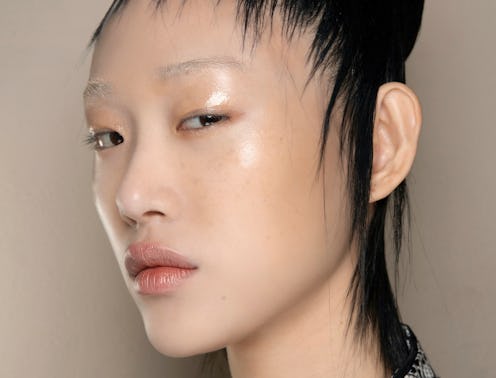(Beauty)
This Skincare Ingredient Is More Hydrating Than Hyaluronic Acid

Just as hyaluronic acid was becoming a household name, a new hero hydrator is looking to top it off its pedestal: polyglutamic acid, a skincare wonder ingredient. The buzzy new kid on the block is slowly popping up in several new serums and moisturizers, just in time for dry skin season.
“Polyglutamic acid (PGA) is a component of the sticky paste found in natto, a Japanese fermented soybean dish,” explains Kelly Dobos, cosmetic scientist and former president of the Society of Cosmetic Chemists. Unlike other cult-favorite acids like glycolic and lactic, PGA is hydrating rather than exfoliating by creating super absorbent hydrogels which swell and entrap water. Much of the excitement surrounding the mega-moisturizer is due to studies claiming its high absorption rate. While data indicates that polyglutamic acid can absorb up to 5,000 times its weight in water over time, Dobos tells TZR that although it is undoubtedly a powerful humectant, we must be wary of the facts and figures. “These types of in-vitro studies provide impressive numbers but the extrapolation to actual skin care is likely less exciting." New York-based dermatologist Dr. Michelle Henry, MD, FAAD agrees, stating that the water-holding capacity is influenced by several factors such as the salt and pH of the product and the skin.
Alongside its moisture-boosting properties, there’s evidence to suggest that PGA also increases skin suppleness. “Studies show that during a 28-day period, PGA favorably improves elasticity and of the skin, more so than collagen and hyaluronic acid,” adds Dr. Henry, referencing a 2015 report from the Microbiology Society.
Polyglutamic Acid Vs. Hyaluronic Acid
While both ingredients are naturally occurring humectants, we need to look at HA and PGA as cousins rather than twins. “Hyaluronic acid (HA) is a sugar found naturally in our skin that holds water and helps keep it hydrated,” explains Dr. Henry. As a component of the skin’s natural moisturizing factor, it is predominately found deep within the dermal layer. Found in most popular skincare products, we’ve grown to love it for its multiple benefits. “It helps keeps skin supple and is an important factor in wound healing,” Dobos says, adding that, it does gradually deplete with age and environmental factors like excessive sun exposure.
PGA, on the other hand, is a water-soluble peptide with a larger molecule size, which prevents it from penetrating as deeply. Still, it does have had mild occlusive benefits, explains Dr. Ranella Hirsch, MD, FAAD, board-certified dermatologist. “With PGA, a soft film ‘develops’ on the skin that prevents the evaporation of water. The theory is that HA helps attract water to the deeper layers of the skin while PHA, via its sealant qualities, helps maintain hydration at a higher level in the skin.” To analogize, hyaluronic is akin to wearing thermals that sit closer on the skin. Polyglutamic is your puffer jacket on top, also creating warmth but most importantly, trapping all that heat in.
Polyglutamic Acid's Benefits
Hydration is key for happy, healthy skin that functions optimally. “In marketing terms, hydrated skin often means smooth and soft skin. But speaking more scientifically, it’s a parameter that we measure to assess the status of the protective skin barrier,” Dr. Hirsch explains. As we move into cooler temperatures, it could be used as a hydration booster for an extra dose come fall and winter.
If you’re lusting for rejuvenated and refreshed looking skin, PGA might become your new BFF as it helps to delay a natural process that happens as we get older. “PGA in moisturizing products helps inhibit the action of an enzyme called hyaluronidase, which breaks down the natural hyaluronic acid in our skin. By using topical HA and PGA together, you get a prolonged impact of the HA,” says Dr. Hirsch.
How To Add Polyglutamic Acid In Your Skincare Routine
As PGA has a larger structure than HA, layering products in the right order is essential. Safe and suitable for day and night use, if using a separate hyaluronic acid serum, it would need to be applied before your PGA product which acts as the protective sealant. Alternatively, reach for a product that contains both to take out any guesswork.
Dobos hints that in the future, PGA won’t solely be found in skincare. “It’s been studied in hair care applications where it has demonstrated the ability to strengthen and protect hair from damage during the bleaching and coloring processes.” Given that PGA is edible, water-soluble, and biodegradable, we expect several new launches with this multi-functional powerhouse but read ahead for our top skincare finds so far.
We only include products that have been independently selected by The Zoe Report’s editorial team. However, we may receive a portion of sales if you purchase a product through a link in this article.